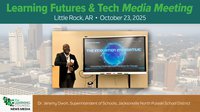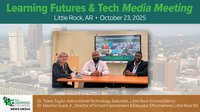The idea of an AI schooling model has caught on already in K12. Not as a “tool,” but with AI as an infrastructure. Not as teacher-less, but more humanized, using teachers precisely and unburdening them of anything but teaching, diagnosis, mentoring and inspiring students. When AI is positioned to use not just Generative AI (text bots), but also Time AI and other types such as Diffusion to generate images, the whole of this Omni-AI also connected into a school’s various platforms, then the ability to provide both path and pace adjustments is real. Real teaching is still in the mix, just reorganized into small group batches on demand.
Schools are standing at the threshold of the most consequential redesign since the invention of public education. Artificial intelligence is no longer confined to commercial chatbots and grading tools—it is has the ability to shape time itself inside learning. The rise of Omni-AI systems—AI architectures capable of orchestrating curriculum generation, personalization, and live teaching intersections dynamically—signals a structural shift from industrial-era schooling toward time-fluid, pace-based learning ecosystems.
In this new model, Time AI manages each learner’s rhythm and flow. Students study in homeroom-like environments where learning is both local and virtual, and where teachers can “reserve” real classrooms for live togetherness when group instruction makes sense. Courses form and dissolve based on pace, not room+timeblock assignments. Curriculum evolves from standards, digital libraries, and teacher creativity—all woven together by generative AI. The school becomes less about rigid scheduling and more about orchestrated learning presence.
Yet this transformation faces not only cultural but regulatory resistance. The current legal and bureaucratic frameworks of education were written for a world of bell schedules, paper textbooks, and age-graded cohorts. To truly move into Omni-AI operation, leaders must confront and re-engineer the underlying constraints.
The Issues
1. Seat Time Requirements
The problem: Funding and accountability systems still equate learning with physical attendance. State codes specify a minimum number of instructional minutes per day or year, often assuming a teacher must be present for all of them.
The shift: In an Omni-AI structure, supervision can be documented through continuous AI engagement and teacher availability on demand. The “time” of instruction is no longer bound to a single classroom or moment—it’s distributed across digital and live learning blocks.
Solution path: Redefine “seat time” as school-supervised learning time, regardless of physical proximity. Time AI can log precise engagement data, giving administrators defensible evidence of instructional minutes. Besides, laws in place in any State do not apparently indicate that the teacher has to be in the same room the entire time requirement. Competency-based pilot zones and innovation waivers already offer precedent for this reinterpretation.
2. Grade-Level Testing and Advancement
The problem: State testing still ties performance to chronological age or grade, sometimes the same grade across all subjects is enforced, preventing students from being “sixth grade in reading” and “eighth grade in math” simultaneously.
The shift: AI can naturally stratify students by level rather than age into courses the teacher selects, and then use Time AI pacing to allow learners to take longer or shorter times in each lesson depending on their need.
Solution path: Tests could be administered by subject-by-grade rather than every-subject-in-one-grade, or operate within grade bands (e.g., 3–5, 6–8) so students can advance by subject while remaining within their official accountability grade. Locally, schools can document progress through AI-generated curriculum maps per student, then use those records to justify waivers or to participate in competency-based pilot programs.
3. Teacher Certification and Oversight
The problem: Most states require a certified teacher of record to be “providing instruction” to each student, an assumption that doesn’t fit fractionalized time or AI-assisted delivery.
The shift: The teacher’s role becomes supervisory, mentor-based, and design-focused—still legally “in charge” of instruction but amplified by AI co-teaching and monitoring systems.
Solution path: Create AI Co-Teaching protocols in which teachers maintain instructional authority while AI handles personalization, data tracking, and content assembly. Fractional time models allow teachers to manage broader cohorts while preserving compliance.
4. Carnegie Units and Credit Systems
The problem: Credits are still awarded for “hours of instruction,” not demonstrated mastery or just completion of a course.
The shift: AI systems can track completions and/or mastery continuously, producing quantifiable proof of achievement at any moment.
Solution path: Convert learning progress into Completed Units equivalent to Carnegie hours. Use Time AI’s audit logs to establish “learning time equivalence” for state recognition. Several states already accept this within competency-based education frameworks.
5. Attendance and Truancy Reporting
The problem: Attendance is defined as physical presence in a room, forcing online and hybrid models into compliance gymnastics.
The shift: AI environments can track real learning—keystrokes, assessments, collaboration, AI check-ins—producing granular engagement data far beyond what a roll call can prove.
Solution path: Redefine attendance as active participation in school-authorized learning activities, verified by digital trace data. Virtual schools have already paved the way for this standard.
6. Funding and Staffing Formulas
The problem: Per-pupil funding and teacher allocations are based on fixed class ratios and full-time equivalents.
The shift: Ratios can stay the same across greater geographies and more course assignments to teachers. In an AI environment, fractionalized teacher time, shared instructional resources, and cross-district learning exchanges become normal.
Solution path: Build AI analytics to document cost-efficiency and demonstrate equal or greater instructional coverage. Innovation waivers and inter-district compacts can legally share funding responsibility.
7. Curriculum Approval and Accreditation
The problem: States often require pre-approved textbook adoptions, digital resources, and fixed course codes.
The shift: Omni-AI generates personalized learning sequences assembled from these adoptions and other diverse digital libraries, mapped in real time to standards so every path is a “liquid curriculum” but still adhering to requirements. It can also adapt to all languages on-the-fly.
Solution path: Maintain or build in your AI the alignment metadata proving that every AI-assembled pathway meets or exceeds the required objectives and uses digital and paper version adoptions. Establish accreditation templates that certify by learning completions rather than course title alone.
8. Data Privacy and AI Accountability
The problem: FERPA and emerging AI regulations demand transparency about how data and recommendations are used.
The shift: Omni-AI environments depend on data but can also create new levels of visibility.
Solution path: Implement Explainable AI protocols and “Data Dignity” practices—teacher override, audit trails, and open algorithm documentation—to assure compliance and public trust.
The Deeper Meaning: From Control to Orchestration
The greatest transformation of all is philosophical. Traditional schooling is a system of control—time, space, and attention fixed into predictable containers. Omni-AI schools shift to orchestration, where time becomes a designed medium and learning is conducted like music—responsive, layered, alive.
Homerooms become community anchors where students find identity and mentorship, not static classrooms for all instruction. Teachers evolve into conductors of time and problem diagnosis, not just deliverers of uniform content in lock-step or having to do myriad customizations for the 30-40% of every class that are mixed ability and off grade band learners. The school itself becomes an intelligent organism, continuously shaping and reshaping its learning patterns through AI insight.
The Road Ahead
The barriers to Omni-AI schooling are not technological—they are bureaucratic, regulatory, and psychological. But every one of them has a legal or operational workaround already visible in existing innovation statutes. The task ahead is for educational leaders to reinterpret legacy rules through the lens of AI-enhanced learning rather than wait for the law to catch up.
AI is the enabler of freedom from the factory model. It measures what matters—time spent truly learning, not time spent sitting through each linear time block. It personalizes, documents, and adapts at a scale no human system could. The opportunity now is to reimagine schooling as living intelligence, where human teachers and artificial intelligences together create the most individualized and meaningful education humanity has ever achieved.
***











